This week we round off Marine Month with a trip to the bottom of the ocean, meeting underwater robots and using maths to hunt for sunken treasure ships. Plus, a way to predict organ failure in hospital, and why size really does matter when it comes to speed.
In this episode

00:51 - Organ failure: Who gets hit?
Organ failure: Who gets hit?
with Jo Shepherd, Queen Mary University of London
Every day thousands of people around the world suffer serious injuries from accidents. Many die at the scene, but a significant number survive the initial insult only to develop a fatal complication later called multiple organ dysfunction syndrome. But why do these victims die, and who's at risk? Chris Smith spoke to Jo Shepherd, a surgeon based in London…
Jo - We looked at the very early immune response to trauma, so major injury. This can include anything from being hit by a bus, being stabbed, falling from a height, so any physical injury to the body. There are about 50 patients a day day in the UK die from critical injuries such as these but, in those who survive, there’s a huge chance of developing what we call multiple organ dysfunction syndrome, which is essentially a failure of organs in the body including the heart, lungs, liver, kidneys, and brain. Even though they’ve not been directly injured the body’s immune response can become disrupted or exaggerated and we think that this causes organ dysfunction.
Chris - So you’d quite like to know who the people are who are at risk of developing that so you can anticipate it and then perhaps even stop it?
Jo - Exactly. It’s a huge imperative in modern medicine that we try and find out why these patients are developing multiple organ dysfunction and, therefore, we can try and figure out how we might be able to treat it.
Chris - How have you done it?
Jo - We took blood samples in the resuscitation room from 70 critically injured patients, so the first minutes to hours after injury. What we’ve done is try and study the immune cell composition within those blood samples, looking both at the numbers of different types of immune cell in the blood as well as the genes that might be affecting those immune cells.
Chris - And your rationale is that if you look at what the genes are, and you look at what the cells are, and you know which patients go on to develop this syndrome, you’re looking for a sort of cell and gene fingerprint which is a predictor of who might be at risk of developing this multi organ dysfunction syndrome?
Jo - Exactly. We’re looking to see what genes in our immune cells are activated, and what genes are maybe downregulated or suppressed so we think if we can find out what those initial key actors are in the first minutes or hours after injury; we might be able to figure out what is driving this huge response that we see later on down the line. And that’s not only useful for predicting organ dysfunction but it also opens up a huge avenue for discovery research to see are any therapeutics that we might be able to develop that can maybe modify that response.
Chris - How far have you got? Have you got some fingerprint changes now that are good predictors of people who might be at risk?
Jo - Yeah. We found that in the first window of injury, so that hyperacute phase, there are very specific immune changes that occur in that time frame which by 24 hours are no longer visible. We found a couple of key areas which might be important for subsequent development of therapeutics. One is the role of blood immune cells, things like natural killer cells which are a type of white blood cell. Neutrophils are also implicated in this response. So these are two cells types that we can start to work with to see if there’s anything we can develop to alter their response. But also with certain cellular pathways, these cell death pathways, were also featured very prominently and if we can find a drug or a therapeutic that can enhance cell survival, then we may be able to protect against organ dysfunction.
Chris - Do you think these people who you see who are at risk, is that something that they’re born with as in that’s part of their genetic repertoire? Or is it that the pre-existing situation perhaps they’d had a viral infection or they had something else wrong with their health that put them into this vulnerable state?
Jo - We don’t fully know the answer to that. We don’t know if it’s because of a patient's individual genetic makeup, or something that might have affected their genes as they were growing up, or up until the point that they had the injury, or whether it’s something to do with the injury itself specifically. These are still big questions that we need to answer in order to fully understand why some patients develop multiple organ dysfunction syndrome.
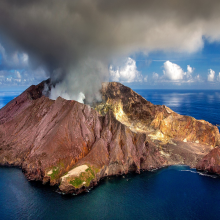
05:01 - Volcanoes and the carbon cycle
Volcanoes and the carbon cycle
with Sasha Turchyn, University of Cambridge
When volcanoes erupt, huge amounts of carbon are released into the atmosphere. Historically, we have believed this carbon came from deep inside the Earth, however new research from Cambridge University has upended this notion. Georgia Mills spoke to Sasha Turchyn...
Sasha - We’re really interested in understanding how carbon moves around the planet. When we think about the carbon cycle you often think about the movement of carbon between the atmosphere, or into the biosphere, or into the oceans. On geological timescales, so tens of millions of years or hundreds of millions of years, we think about the carbon cycle as carbon that comes from volcanoes into the surface of the planet and, eventually, after a certain amount of time will become a rock or a mineral and return back down into mantle, or back down into a rock form where it’s locked up for a while. That geological carbon cycle that’s been an open question for a little while to understand exactly how carbon is coming out of the surface of the planet and how it actually gets removed from the surface of the planet.
Georgia - So you’re interested in where this carbon was actually coming from - the volcano shoots is out into the atmosphere but where is it from originally? So how did you go about looking into this?
Sasha - We used something called isotope ratios. When we think of carbon, we think of carbon having 6 protons and 6 neutrons, but actually 1% of all carbon has an extra neutron in the nucleus. So, because of that we can use that ratio of the heavy carbon to the light carbon to understand the source of that carbon.
We had this question a long time ago, maybe 7 or 8 years ago and there weren’t many measurements made just yet, and over the last 7 or 8 years there’s been many more measurements. There’s been an explosion in the number of measurements that are reported in literature. So, when we went and revisited this question with a Master’s student, Emily Mason, who’s the lead author of the study, we went back this past fall and we could see that there was enough data that had been developed of this isotope ratio, which is effectively a chemical fingerprint of where the carbon comes from to be able to say something that was significant.
Georgia - I’ll ask you where you found the carbon was from in a second, but I’m curious. I’m imagining someone with a test tube standing over a volcano - how do you get these samples?
Sasha - Well, there are some test tubes over volcanoes, but no-one falls in any more. One of the advances that’s happened in the last 7 or 8 years is that the analytical capabilities have meant that you need smaller and smaller samples sizes. And that has allowed people to take very small vials, either from fumeral gases or through bags attached to pumps on the ends of camping poles. I’ve sampled things like methane in saltmarshes, and there we can take a tent pole with a bag and you can swirl it using a small vacuum pump and you can sample it in about a minute or two. In a similar way you can do this, you don’t do this in super hot parts of the volcano, but in some of the more dispersed parts of the volcano you can sample the gases pretty easy.
One other advance that’s been great in the last few years is you can make some of these measurements on site, which has allowed for more measurements to be made.
Georgia - So what did you find? Where is this carbon that the volcanoes are shooting out coming from?
Sasha - A lot of it is coming from the surface. A lot of it is from other rocks that are very close to the surface and not from as deep in the mantle. It doesn’t have that characteristic sample of deep mantle carbon that we were expecting to find. But what was most interesting is the volcanoes that are putting out the most CO2 - things like the Italian volcanoes - they’re very, very big CO2 emitters, so is Papua New Guinea for example. Those ones had the most carbon that was coming from the surface. Whereas other volcanoes like the Alaskan Ark, they were putting out mantle carbon, they’re not putting out quite as much CO2. So once you did a weighted average of both the amount of CO2 and its chemical fingerprint, it was very heavily weighted towards the crustal recycling.
Georgia - Why is it important to know this?
Sasha - That isotope fingerprint is the primary tool that we use to reconstruct the carbon cycle over geological time. So if I’m interested in 500 million years years ago, or a billion years ago understanding how much carbon was coming out, how much carbon was going down, how was it going down, was it related to animals or not? I’ll use that carbon ratio. So if the ratio in volcanoes can change systematically over time then that implies that we can’t trust those measurements from deep in geologic time for understanding the carbon cycle.
Georgia - I see. So it’s kind of changing what we understand the history of the carbon cycle will have been?
Sasha - We’ll have to rethink some of our interpretations. We have interpreted changes that have been measured to be attributed to say changes in some process at the surface, but it may be a change in the type of volcanoes that are around.
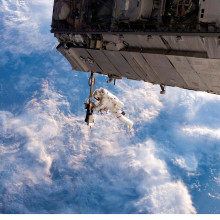
10:35 - Down to Earth: Carbon capture
Down to Earth: Carbon capture
with Stuart Higgins
In this week’s Down to Earth, where we take a look at tech intended for space which has since found a new home down here on Earth, physicist Stuart Higgins looks at a technology to soak up CO2…
Stuart - Every day we each breath out about a kilogram of carbon dioxide, depending on how active we’ve been. Back down on Earth, the carbon dioxide we produce forms part of the carbon cycle. It’s used by plants in photosynthesis to grow into crops that we eat and then so on...
But when you’re orbiting the Earth in a space station one or two houseplants aren’t going to be enough to keep up with the CO2 you’re producing. Without a means of removing carbon dioxide the concentration in the air will quickly rise to dangerous levels. So one of the key technologies for space exploration is carbon dioxide absorbers. These are chemical sponges that mop up the excess carbon dioxide in the air allowing astronauts to breath freely.
The European Space Agency ESA has been working on a new life support system called the Advanced Closed Loop System for the International Space Station which will help scrub the air of carbon dioxide as well as generating oxygen and water. It’s designed to remove 3 kilograms of carbon dioxide per day, the equivalent of roughly three astronauts, will work alongside existing systems on the space station. It works by passing the carbon dioxide-containing air across a bed of absorbant beads. The beads are made up of a resin coated in a solid amine based chemical.
Amine is the name given to a chemical compound with a nitrogen atom that has a spare pair of electrons. And by spare, I mean that these particular electrons aren’t directly forming chemical bonds with other atoms in the compound. These spare electrons make the amine group reactive, they’ll bind with the slightly acidic carbon dioxide flowing over them.
Eventually, the beads will absorb as much carbon dioxide as they can. At this point, the absorber can be shut off from the rest of the spacecraft and steam passed over the beads. This causes the release of carbon dioxide which can then either be released into space or used in other experiments on board the space station.
The same technology is now being used back on Earth to capture carbon dioxide from the atmosphere. Rather than using it to keep astronauts alive, a Dutch company has developed the same ESA technology to extract carbon dioxide from the atmosphere. They aim to use it to improve the atmosphere in closed environments such as airplanes and crowded buildings. And as a way of producing a continuous carbon for example for farmers who might want to raise the carbon dioxide levels in their greenhouses to help plants grow.

13:39 - Quantum computer plans unveiled
Quantum computer plans unveiled
with Winfried Hensinger, University of Sussex
In the Hitchhiker’s guide to the Galaxy, the supercomputer ‘Deep Thought’ was given the challenge of solving the meaning of life, the Universe and everything. The answer was, as fans will know, a rather disappointing 42. But now we may be getting closer to building such a computer ourselves. Because scientists from the University of Sussex have come up with a design for what would be the most powerful computer ever built. It’s a quantum computer and commentators say machines like it will transform the fields of medicine, e-commerce and, who knows, possibly tell us the real answer to life, the Universe and everything. Izzie Clarke met with Winfried Hensinger, who’s leading the project.
Winfried - It’s really big. Right now it fills a huge laboratory and as we build a large scale machine it will certainly fill a whole building and maybe it will fill a whole football pitch. Think of it as a masterpiece of engineering; tremendously difficult engineering.
Izzie - For one day only, a large bunker was placed in the centre of London which displayed the blueprint to building the most powerful computer on Earth. But, this isn’t a computer as we know it. Using planes and planes of microchips, scientists can use charged atoms called ions to carry out enormous calculations using the laws of quantum physics...
Winfried - Quantum physics is a very, very strange theory and has really wierd predictions. An atom can be in two different places at the same time. So you could be standing here and you could be at home having breakfast all at the same time, and that actually exists in the world of quantum physics. We train these quantum effects in order to build a very, very powerful computer which is nothing like a normal, conventional computer.
Izzie - The key to this quantum computer is that its circuit can operate by not just being on or off like a switch, but by occupying a state that is both on and off at the same time. This is down to quantum mechanics, which allow very small particles to be in different places simultaneously, where they stay in these states until they are either observed or disturbed. It’s a bit like flipping a coin. The coin is both heads and tails when it’s in the air but it’s only heads or tails once it’s caught...
Winfried - What you actually see is a very authentic model of a quantum computer as we have it in our lab at the University of Sussex, which has a vacuum better than that of outer space. Inside this vacuum system there are silicon microchips. We’ve developed a new way where you apply voltages to one of the these silicon microchips and we use these to produce electric fields, and these electric fields make individual charged atoms, or ions, that levitate above the surface. What we’ve shown is a new type of approach to quantum computing.
Izzie - It’s on these small particles that information is encoded. Our standard computers carry information in bits with values of zero or one. Quantum computers use quantum bits or qubits, where they can be both zero and one. Previously, small scale quantum computing methods used lasers to help process the calculations carried out by these qubits. However, that provided some issues when upscaling…
Winfried - Imagine you wanted to build a large scale quantum computer which would require millions or billions of qubits. Imagine you need to align millions or billions of laser beams with the accuracy of a hundredth of the width of a human hair. What we’ve done is we’ve taken away all this requirement of using all these laser beams and instead replaced them that with voltages to apply to a microchip.
Izzie - Because these qubits can be in multiple values at the same time, more information can be encoded on them. We’re talking about calculations that even the fastest supercomputer would need millions of years to calculate. For such a powerful computer you’re going to need a pretty big circuit board known as a module. It’s a large, flat microchip that contains lots of routes for the ion to move across, along with control electronics that allow this movement. Their motion actually looks like a game of Pacman. And more modules means more ions and that’s what increases the computational power...
Winfried - We’ve developed a new way to connect modules. Traditionally, people thought you’d have to use an optical fibre, so we came up with a new approach to do this. We move ions using electric field connections from one module to another and with that we are going to be able to do this 100,000 times faster than the state of the art technology around right now. And this is the second exciting breakthrough we have.
Izzie - In some aspects a quantum computer works in a similar way to a standard computer running calculations based on an input. But, thanks to quantum, both the information a quantum computer can store and it’s power is incomparable.
Imagine you were looking for someone in a public phone book. The standard process would be to go through each entry individually until you found the right person. Because these ions can take multiple states, a quantum computer would be able to search every name and number, so that’s every single possible answer, all at the same time. But what can we use these quantum computers for?
Winfried - Quantum computers can tackle problems even the fastest supercomputer would take billions of years, so it’s a whole set of opportunities. For example, creating chemical reactions like creating new pharmaceuticals. Being able to understand how to make new materials; stronger materials but lighter materials. Think about optimisations in the the stock market - very quickly, classical computers just run out of computational power. It’s more like getting a new capability that you didn’t have before...

19:60 - Size matters when it comes to speed
Size matters when it comes to speed
with Walter Jetz, Yale University
How fast should an animal be able to move? And why are the biggest animals, which pack more muscle, not the fastest? That’s what Yale scientist Walter Jetz was wondering, so he and his colleagues looked at hundreds of animal species and have come up with a new theory that successfully puts a speed limit on most species. Tom Crawford heard how it works...
Walter - There is a theoretical maximum speed that is expected to increase with body size. However, in order to actually get to any speed you need to first accelerate, and that’s where the crux is for the really large bodied animals. They need much, much longer time, given their larger size, to accelerate. That’s why it takes a really large truck longer to get up to 60 mph than it does a small car or, indeed, a motorbike. What we were able to show is that large bodied animals simply don’t have sufficient amounts of energy on board, if you will, to ever get there.
Tom - Yeah. In terms of maximum speeds, I notice that as you mentioned in general, the speed increases with the body mass and the size of the animal and then it begins to tail off and decreases with the large animals. It’s almost like a hump shape?
Walter - Correct. And it’s really fascinating that the relationship applies all the way down to insects well below a gram in size, and then reaches this peak at medium-to-large bodied animals, and then drops off. Our theory does a good job we believe in showing what is maximally possible. But then, how close you’re getting to that will really depend on what your particular evolutionary group that you’re in happens to have tried to maximise over the millions of years in which it has evolved.
If you think about a leopard or cheetah, they are actually smaller than us but they are, of course, the fastest land animals. There you are looking at a group that over millions of years evolved to outrun their prey.
Tom - How successfully did your theory fit the actual data.
Walter - The first author of the study, Miriam Hertz, spent a substantial time trawling through the literature, contacting experts and, in the end, we were able to pull data for about 450 species. Across those 450 species, both on land and air and in the water, we were able to predict the observed variation tremendously well with the theory that we have developed.
Tom - What can we hope to learn from a study such as this?
Walter - Movement is a very fundamental aspect of life. The theory that we developed helps provide base expectation about what is the maximum possible speed for animals of a given size. It offers up a really interesting comparison to then say how far in fact is a given species from that maximum possible speed. It can teach us a lot about the various trade offs that a species group may have gone through in the course of evolution.
Tom - Where do we fit into this as humans?
Walter - We humans are actually not too far above that sweet spot where there is enough time and energy given this body size to get close to the theoretically possible maximum speed.

24:01 - Journey to the bottom of the sea
Journey to the bottom of the sea
with Wally Fullweiler, University of Boston
What's it like to journey down to the bottom of the ocean? Georgia Mills heard first hand from Wally Fullweiler, associate professor at Boston University, who has explored the seafloor...
Wally - We get into the submarine named Alvin. The pilot seals the lid and we’re lifted up and into the air and off the stern of the boat into the water. We stare out the window and see the sky, then water, sky, then water, as we bob up and down. The descent begins. First, we move through sunlit, blue waters seeing organisms swimming and dancing in the water. Salps swirl around the windows, gelatinous water column dwelling creatures –translucent, save for their dark orange stomachs and blue rib-like structures. Little, see-through pink shrimp and small jelly fish with hints of auburn slide across our view.
Before we know it the light is almost gone and the water is this amazing dark blue, green, grey – and then darkness. The light is gone at around 200 m. For a brief moment it’s pitch black - and the we see them. We see the light – all the flashing lights. Tiny sparks that are barely discernible and then big, bold, dramatic blazes. For just moments, we see the ghostly outlines of their bodies. We are descending too fast to know what they are - but likely they’re scores of bioluminescent fish, jellyfish, squid, and sea worms. We are falling through an ocean of stars.
Scared? Not at all. I’m in awe and I’m in love. The joy of seeing this is immense – it’s more beautiful and peaceful than I imagined. It’s like home. And then we’re on the bottom. A gentle landing on soft mud with lights turned on for illumination. There are legions of red crabs with arms raised ready to defend themselves against our weird metallic ship and scores of eels skidding slowly along next to them. In our fleeting hours on the bottom, we observe streams of methane bubbles, thick white microbial mats, and moon-like carbonate rocks with bacteria mats growing on them that look like thick coats of brown hair. We squeal with delight at large anemones the colour of intestines and a black urchin the size of a dinner plate. Alvin’s arm and hook-like hand, controlled by our pilot, deftly collects samples. Silvery fish with large bright eyes inspect our work, before, all too quickly, it’s time to go back to the surface again.
Georgia - Thank you for relating that - that sounds fascinating. And the thing you mentioned that you weren’t scared at all but it does sound quite scary and also quite claustrophobic. How big was this thing you were sitting in?
Wally - It’s super tiny and it only fits three adults. So there’s a pilot and he sits in the middle of you facing forward and then there’s a bench on either side of the pilot for one of the divers. You can sit there on the bench or you can lie down on it, but it absolutely is very tight and closed.
Georgia - How deep did you go?
Wally - We got to go to 11 hundred metres.
Georgia - How does that compare with how deep other people have gone?
Wally - Most of our ocean hasn’t been explored and the Alvin can go to a depth of 45 hundred metres right now. With its recent upgrades it’s really close to being able to go to 65 hundred metres. So if it goes to 65 hundred metres, we can explore over 90% of the ocean. But right now it’s still rated at the 45 hundred metres.
The deepest anyone has gone is James Cameron, the movie director, and he went down in the Mariana Trench a couple of years ago and he went down over 10 thousand metres.
Georgia - You mentioned this submarine called the Alvin - what is the Alvin’s purpose?
Wally - The Alvin has been around since the 1960s and its purpose is to explore the ocean. You’ve often heard we know more about the Moon than we do about the ocean and the bottom of the ocean, and that’s true. It provides a really valuable opportunity for scientists to go and really experience first hand, and see first hand what the ocean floor looks like.
We have other types of vehicles that are unmanned, and they can also go deep and they can be down there for longer periods of time which certainly provide other benefits. But I think there’s nothing like actually being able to see it with your own eyes.
Georgia - I’m thinking now of when you fly on an aeroplane - it sometimes does funny things to your head with the pressure. Do you get anything like that but in reverse when you’re going down that deep?
Wally - Yeah, that’s a really great analogy to give because it’s basically the same idea as an aeroplane, just in a different direction. Sometimes I think people get kind of woosy and you can certainly, just because of the air pressure if there’s any change there. I did not notice any of that. I think the larger issue that people have is when you come up to to the surface, there’s a few moments where you’re bobbing around on the surface waiting for the boat tender to come get you to pull you back on the ship. And she’s not the most elegant ship at the surface of the water, so there’s a lot of bobbing and I think people get seasick.
Georgia - Oh no. In a cramped, three-man submarine!
Wally - Yeah. You become very close with your pilot and fellow diver.
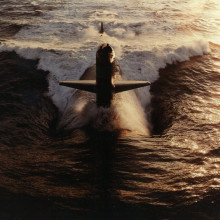
29:55 - Underwater robots!
Underwater robots!
with Professor Russell Wynn, National Oceanography Centre
The bottom of the ocean is one of the least explored areas on earth - so what’s the best way to explore it? As well as sending people down, you can send autonomous submarines. Graihagh Jackson spoke to Professor Russ Wynn, Chief Scientist of marine robotics from the National Oceanography Centre.
Russ - There’s a lot of different uses of marine robots in the sea and some of them are either dull or dangerous or what we might call dirty. So there’s applications in the marine environment where we might want to send out a marine robot to do something for months at a time that would be really boring if you were down there doing it yourself.
There might be areas we want to access, such as under ice in polar regions, where we just physically can’t get to at the moment with manned vehicles.
There might also be areas where we would need to respond rapidly in a situation that could be both dirty and dangerous, like an oil spill, where the ability to send a robot out quickly or to send a 100 robots out quickly would give us an advantage. And, again, that’s something we couldn’t do with manned vehicles.
Graihagh - A lot of applications there. But also down there you have to deal with astonishing pressures - how do you engineer something to ensure that they just don’t get crushed under all that weight?
Russ - We run a fleet of yellow submarines at Southampton that are depth rated down to 6,000 metres. Actually, when you see the yellow submarine, and some of the listeners will be familiar with images of Boaty McBoatface and other yellow submarines…
Graihagh - I’m thinking of the Beatles. We all live in a yellow submarine…
Russ - Exactly. That’s really what they look like - they just don’t have people in. The actual outer shell is fibreglass and it’s free flooding, so that outer shell isn’t totally depth rated to those pressures. What we have inside, the important bits of the vehicle, like the computer, the batteries, the sensors, they’re all individually pressure rated and inside aluminium or titanium housings that mean that they can withstand pressure down at depths up to 6,000 metres.
Graihagh - When you say “flooding,” do you mean literally parts of the submarine flood whilst these other areas - these electronics - don’t flood?
Russ - That’s right, yeah. The outer hull, the water comes into that and so it’s neutrally buoyant effectively, and the inner important bits, the guts of the machine, are the ones that we really protect. It’s a bit like a human being. You’ve got your ribcage that protects your really important bits, but your skin is what’s holding all the water in.
Graihagh - It’s an interesting thought, isn’t it? I dread to think what would happen to our skin if we went down that deep! Now are these things entirely autonomous or are they something that you control from the surface?
Russ - At the moment we have two types. We have surface vehicles that we can communicate with via satellite - a little bit like mobile phone communication. So with those surface vehicles we can keep in contact with them all the time, get data back from them and talk to them and command them to do different things.
For the vehicles that go down into the depths. At the moment they have typically have an endurance of a few hours to a few days. And what we’ll do is we’ll give them a mission that will go into the computer of the vehicle. The vehicles will then go and complete its mission as best it can and then it will come back to the surface and it will be collected.
At the moment they’re relatively unintelligent and what we’re moving into now is an era where those vehicles will actually be able to adapt to the environment that they’re in. So, if they find something interesting on the seabed, they will be able to make a decision about how they then go and change their strategy to go and look at that in more detail.
Also, we’re looking at having the vehicle's processing a lot of the data they collect onboard and they can only then send snippets of those data back to us, maybe via a surface vehicle that acts like an acoustic communications gateway. That way it means they’re sending back the really important information so that the pilot back home can then make a decision about what to do next.
Graihagh - Can you give me a couple of examples - perhaps your favourite missions that are going on?
Russ - Boaty’s the yellow sub that many of the public will have heard of and it’s just come back from a great mission down in the southern ocean near Antarctica where it’s flying around in a current where cold water is being transported from the poles into the rest of the ocean. We’re trying to understand how variations in that current might reflect a wider signal of global warming and environmental change. So, by actually being able to fly Boaty within that current for periods of up to 3 days at water depths of several thousand metres, the scientists that were leading that project got new insights into that current and how it might be varying over time, and there’s no other way they could have collected those data.
We’ve also just come back from a mission in the north sea where, again, a boaty type submarine was looking at how we can use that technology to monitor our ability to store carbon dioxide in sub-sea storage reservoirs in areas like the north sea and lock up that carbon dioxide and, therefore, hopefully mitigate the carbon dioxide levels that we’re seeing in the atmosphere. Obviously, what you want to try and do is make sure that carbon dioxide doesn’t then start leaking into the ocean and then back up into the atmosphere. So we can use these yellow submarines to go out for weeks and months at a time doing very routine surveys of the seabed and making sure that carbon dioxide is locked up under the seabed where it should be.
Graihagh - I do like the fact that Sir David Attenborough’s boat the submarine on board was called Boaty McBoatface. What was the one from the North Sea carbon dioxide mapping one called - do you know?
Russ - The technical name is autosub long range. It’s a vehicle that our engineers developed at the National Oceanography Center. But, actually, that autosub long range family is now what we’re calling the Boaty family. There’s not just one Boaty submarine, there’s 3 and soon there’s going to be 6. So that family’s growing quite quickly and we’ve got all sorts of ambitious missions planned for that family of vehicles in the next few months and years.
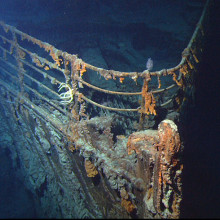
35:48 - How to find a sunken ship of gold
How to find a sunken ship of gold
with Dr Larry Stone, Metron Scientific Solutions
Countless ships and planes have gone down somewhere in the ocean, and finding them is not mean feat. One such vessel was the SS Central America, which sunk in 1857. It was known as the Ship of Gold, and when it went down it had 14,000 kg of gold on board. Obviously a LOT of people were quite keen to find it, but it remained undiscovered. Until, that is, a team of people decided to use something called Bayesian Search Theory, which involves making a map of probabilities using all available data. Larry Stone from Metron Scientific Solutions was involved in this search, and he explained hwo they did it to Georgia Mills.
Larry - The way we went about this search was using this Bayesian Theory. The information available was the last recorded position form Captain Herndon, who was the Captain of the ship SS Central America, who actually went down with the ship by the way, but he hollered his position across to a passing ship about 6 o'clock at night. The ship went down at 8 o’clock. There were passing ships that saw the Central America. Survivors were recovered the next morning at about 8 o’clock. We had a position for that ship that recovered them.
So you put together all this information in this Bayesian framework and the way you do this is by quantifying uncertainties and terms of probability distributions. And then, combining the information into your probability map using something called likelihood functions and likelihood functions are the common currency of information in this Bayesian analysis. You put together all these clues, and that’s part of the trick here because the Bayesian approach is the principle approach for incorporating all the information available to you, both objective and subjective to produce a probability map for the location of the wreck. What the probability map tells you is those places that are high probability for the location of the wreck and those that are low. The high probability areas are where you want to search
Georgia - Let’s break this down. You’ve lost your favourite hat - you idiot! So how can Bayesian Theory help you find it?
Well, you know you often leave it in your bedroom so it’s quite likely to be in there. But you also sometimes wear it in your kitchen and a friend tells you he last saw it in your study. You draw up a grid of locations using all the data available to work out the probability of finding the hat in each location. Maybe taking everything into account it’s got a 70% chance of turning up in your bedroom but only 20% of being in the bathroom.
But what makes this special is you can update your data as you go. For example, another friend says they heard a rumour it was in the attic so you increase the probability of it being there. Or you search a room once and don’t find it so the probability it’s there reduces. And this is key, even if you’ve looked in a place, it can still have a higher probability than being somewhere else. So, according to your model, it sometimes makes sense to search somewhere twice before searching somewhere else.
Now, imagine you’ve got a lot more data, a lot more places to look, a few more computer processes to play with, and that’s largely how Bayesian Theory is used to find wrecks full of gold on the bottom of the sea. Speaking of which…
Larry - In the case of the SS Central America this worked out. We found the wreck and they recovered a ton of gold bars and coins and sailed back into the harbour in Norfolk. There were bands, and newspapers, and television showing their arrival.
Georgia - It’s the find of the century. Maths of all things is used to find a ship lost for hundreds of years. And everyone ends up rich and lives happily ever after…
Larry - Well, sadly it didn’t end quite that way.
Georgia - Ah. First off the old insurance companies who’d paid out when the original ship demanded, and were rewarded, in court a substantial amount of the gold recovered. And then it was up to Tommy Thompson, the team leader, to divvy up the rest between the investors.
Larry - But no. For some reason he didn’t do that. He didn’t sell the gold, he didn’t give the investors any information about what he was doing with the money. He borrowed a lot of money and finally the investors asked him to show up in court to explain what he did with the money. Instead of showing up in court in Ohio, he fled to Florida for a couple of years and was finally arrested down there, and he’s now in jail until he will tell people, the investors, what he did with the money. That’s the sad end to that story, unfortunately.
Georgia - Well, this story doesn’t have a particularly happy ending; Bayesian Theory is still used all the time in modern day search operations…
Larry - We did this, also, for the search for the Air France 447 flight that crashed on it’s way from Rio to Paris. The people in charge of that search were the BEA (the French Bureau of Enquires and Analyses) and they had, for two summer seasons, searched unsuccessfully for that wreck. Then they contacted Metron and me and said would you use all the information available from this search. Not only the last reported position of the aircraft, but the debris that drifted and was picked up, and all the unsuccessful search that was done. So we incorporated all that into a probability distribution for them and the next summer, beginning of the early spring season, they began a search looking in the high probability region of that probability map that we delivered to them and they found the wreck within one week of search. So that’s a big success story.
Georgia - Oh Wow!
Larry - It doesn’t always happen that way but it’s very satisfying when it does.
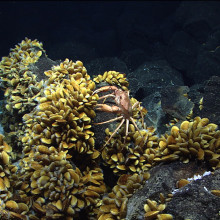
41:53 - Deep sea mining: good idea or huge mistake?
Deep sea mining: good idea or huge mistake?
with Dr Jon Copley, University of Southampton
Now, we can explore the deep, with robots, manned submarines and we can use maths to help find certain things, but why? Well, apart from salvaging things we’ve lost down there, there is also an entire hidden world with new creatures and rare chemistries waiting to be understood. In fact, the bottom of the ocean is of interest to many mining companies, as it is rich in many rare earth elements. But should we mine the deep? Graihagh Jackson heard both sides from Dr Jon Copley, from the University of Southampton.
Jon - It’s the metals that we need for our everyday lives. Modern technology needs a lot of things like copper; your family car’s got about 30 kg of copper in it. But a hybrid car that emits less CO2 needs about 70 kg of copper. Then there are these metals called rare earth elements that we need in high technology sort of devices. So things like touch screens use something called indium, there’s neodymium which we use to make really efficient magnets for things like wind turbines so there’s an increasing demand for these metals for our everyday lives. There are sources of those metals on the ocean floor so that’s why people are starting to get interested in trying to see if we can mine what’s down there.
There are really three types of mineral deposits on the ocean floor. There’s hot vents where mineral spires grow that are very rich in copper. Then there are manganese nodules that are new potato sized little nodules on the ocean floor - they’ve got a lot of rare earth elements in them. And then there are crusts that form around the edge of undersea mountains called seamounts and then, again, they’re potentially rich in rare earth elements.
Graihagh - You paint a beautiful picture of all these things growing on the seafloor but how would you get them? Would you drill them, would you dredge them?
Jon - One of the attractions of deep sea mining is, unlike mining on land where you have to burrow and tunnel down through a lot of rock to get to the things you’re interested in mining, these are sitting on the ocean floor. So, if you can get down through the water then, potentially, you can scoop those resources up. And, of course, we have the technology as we’ve been hearing about in this programme to operate in deep water. A lot of it’s been developed for offshore oil and gas for the remotely operated vehicles that people use to do things on the ocean floor. You can adapt and develop that technology potentially to mining machines for deep.
Graihagh - I know it was talked originally about in the ‘60s and now you say it’s feasible, but is it economically viable?
Jon - It always sits on a bit of knife-edge. Supply and demand and there’s also some complex economics involved. But back in the ‘60s there wasn’t the demand for the rare earth elements that we have with modern technology today so that is changing things
Now, although they’re called rare earth elements, they’re not necessarily that rare, it’s just that some countries control about 90% of the deposits known on land. So governments are really interested in long term security of supply trying to ensure we don’t get caught in any monopolies in the future and, therefore, interested in exploring new sources.
Graihagh - Okay, I see. Presumably though this is a similar problem at the bottom of the ocean - who owns that bit of land?
Jon - Yeah. Although who owns what at the bottom of the ocean has already been decided at the United Nations through something called The UN Convention on the Law of the Sea. That means that if you have a coastline you get 200 nautical miles, which is about 370 kilometres of ocean stretching out from your coastline unless you bump into someone else’s claim which gets split down the middle.
Then beyond that a lot of the ocean is international waters. The United Nations has created an organisation called the International Seabed Authority to administer deep sea mining in international waters.
Graihagh - Presumably though, with all human activity, particularly mining, there’s got to be some sort of ecological impact?
Jon - Absolutely. And the real challenge in the deep ocean is we don’t understand very much about the patterns of life down there; how things are going to respond to deep sea mining. Each types of those mineral reources that I described has got different kinds of marine life associated with it and they’re going to respond in different ways and, indeed, there are different species in different regions of the ocean. So we have to do an awful lot more exploration and investigation before we can really confidently predict what the impacts of deep sea mining are going to be, so there’s a real challenge for us there.
In 2011, I surveyed a set of deep sea vents in the southwest Indian Ocean in a region where China had already been granted a licence in international waters by the United Nations to explore for mineral resources, but we had no idea what was living at the deep sea vents in that region. We found, at least so far, six new animal species, most of which are not yet known anywhere else in the world other than the site where we were studying. So it’s that kind of thing, it’s exploitation potentially racing ahead of the exploration we need to understand what the impacts are going to be.
Graihagh - Just to play devil’s advocate here, as the old proverb goes “what we don’t know can’t harm us.” So does it really matter if we’re causing these creatures to go extinct?
Jon - In the southwest Indian Ocean, one of the species living at the hot vents there is a wonderful animal called the scaly foots nail, and it has metal plates on its fleshy foot unlike any other snail that we know of so far in nature. And the structure of it’s shell is very good at resisting mechanical damage, and material scientists are learning from that to design better body armour, better crash helmets, better pipeline protection scratch resistant paint. So, if we lose biodiversity, we lose the opportunity to learn from the ingenuity of nature.
But more fundamentally than that, if you look at the history of our species, we’ve often rushed to exploit a resource just because we can, and only later realise the impact we’re having and said hand on a minute, maybe that wasn’t such a good idea. So deep sea mining really, fundamentally, offers us an opportunity to show whether we’ve grown up as a species. Are we still really an adolescent species that just does things because it can, or can we once show that we’ve developed the wisdom to pause and decide whether we should go ahead and do something rather than just rush in and do i because we can?
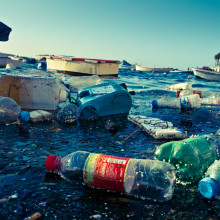
48:02 - The future of the ocean
The future of the ocean
with Jon Copley, University of Southampton
As we end our month of all things marine, we ask the final questions: what future awaits our oceans, and why should we care? Georgia Mills heard the last word from Southampton University's Jon Copley...
Jon - Our everyday lives are connected to the oceans in so many different ways. If you’re listening to this podcast elsewhere in the world, it’s actually coming to across a cable across the deep ocean. All of the internet, all of our intercontinental phone traffic uses the deep ocean. We use a lot of ocean resources, we can learn from the ingenuity of nature in the seas and, of course, our everyday lives are having increasing impact on the deep ocean as well.
Georgia - How is our ocean doing? How much should we be concerned about it?
Jon - Certainly the pressures from our activities on the oceans are increasing from pollution, from the waste that we generate, and our increasing use of resources. But there are also what I like to think of as islands of hope out there. There are examples of where our personal choices in our everyday lives have made a difference for the better.
In the UK, we’ve had the ban on plastic bags in shops and that’s substantially reduced the amount of litter on our beaches. This week in the UK, we’ve also heard there’s going to be a ban on microplastics in cosmetics and some sort of personal care products. So I think that as we become aware of how our lives are connected to the oceans and how a healthy ocean benefits us, then together we can choose the future we want for our blue planet.
Georgia - What are the biggest challenges ahead for the ocean? What is the future and what can people listening who love the ocean do at home to try and help?
Jon - I think we’re all becoming aware of the amount of plastic waste that we tend to generate. If we don’t pay attention to it in our everyday lives and an awful lot of that plastic ends up washed into rivers and so on and, eventually, in the oceans - billions of tons of it. Probably the lion’s share of it has been generated within the past decade or so.
Now people are starting to really wake up to this and we’re seeing some differences. We’re seeing pressure on manufacturers and that’s something that each of us can think about and that collectively will make a difference to the oceans for the future.

50:29 - Critter of the Week: Anglerfish
Critter of the Week: Anglerfish
with Joe Lavery, SeaLife Europe
In the final Critter of the Week, Tom Crawford is here to reveal this week’s villainous candidate.
Tom - Name: anglerfish, Phylum: chordate. Location: everywhere from the shallows to the deep sea. Special abilities: sexual symbiosis and the master of luring unsuspecting fish to their death.
Joe Lavery, marine biologist for Sea Life Europe…
Joe - There are more than 200 species of anglerfish identified. They are found across the world, and whilst some are the size of a thumbnail, others can be the size of a small dog.
Tom - And their names read like a list of super villains… I give you The Humpback, The Horned Lantern, The Tooth Sea Devil, and The Prickler. But where does the name anglerfish come from?
Joe - They get their name from a sort of fishing rod on their head. It’s actually a modified dorsal spine which we call an illicium, and it’s a central part of how the anglerfish hunt. Each illicium has an apparatus at the end and these vary between the species. So whilst some have a lure that resembles a shrimp, others have a photophore that produces a glimmer of light in the dark sea. The form of each illicium is perfectly adapted for the prey that's being hunted.
Tom - So the illicium literally acts like a carrot on a stick. From tricking other fish into thinking its prey to lighting up the dark and attracting smaller fish like moths to a flame. So what happens at mealtime?
Joe - They can go for days on end without eating waiting for the perfect moment to strike, and when the time does come they’re able to eat a fish which is twice their own size.
Tom - Move over snakes, there’s a new swallowing-animals-whole star in town.
Joe - But of all the fascinating traits of an anglerfish, one species takes it to the next level. The deep sea anglerfish lives more than a mile underwater on the desolate ocean floor, and here in the deep sea it’s rare for two anglerfish to meet. So if a male and a female do cross paths they make sure not to waste the opportunity.
When a male angler comes across a female he bites into her. Now lots of fish, and indeed sharks, do this but the anglerfish then excretes an enzyme and, in just a few hours, this enzyme causes the mouth of the male to fuse to the body of the female. A few days later, the digestive tract of the male becomes embedded into the body of the female and, as the male is so much smaller than the female, this means that from now on she will carry him around with her until she’s ready to fertilise her eggs.
Tom - In other words the male really is only good for one thing. Thanks to Joe for talking us through the whole-animal-swallowing, male enveloping, carrot on a stick wearing, super villain that is the anglerfish… Our critter of the week.










Comments
Add a comment